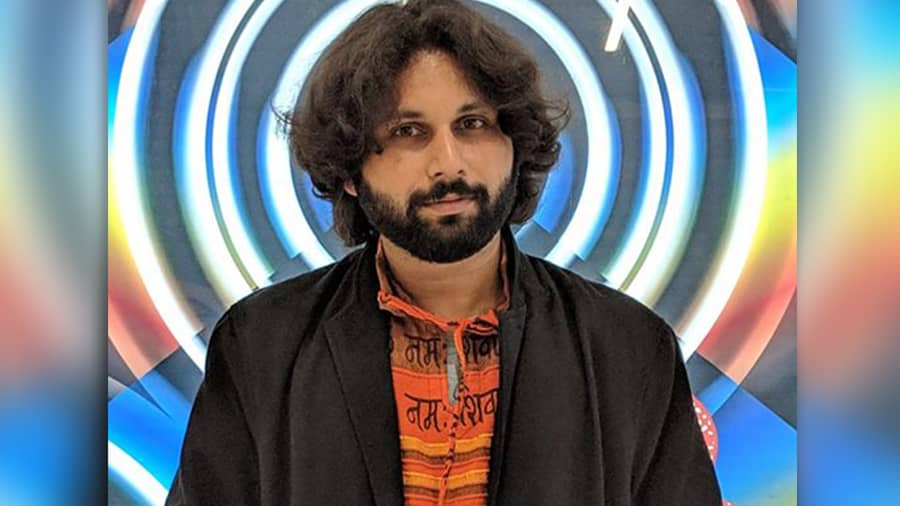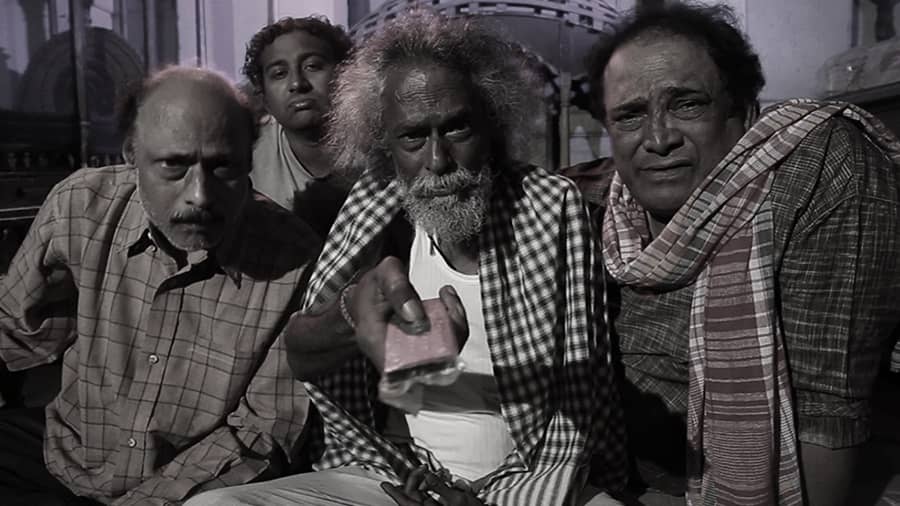Godard is injurious to health!
That’s just about the most memorable line I have come across in a film this year. And what makes it even more delectable is that we hear this in an Odia film set in a back-of-beyond village in Odisha – probably the last place you are likely to encounter Jean-Luc Godard. And therein lies the charm of Adieu Godard -- Amartya Bhattacharyya’s whimsical and often ambitious take on art and its ability to create connections across geographical, cultural and linguistic boundaries, man’s faculty for thought, patriarchy, and so much else.
Ananda (played by Choudhury Bikash Das) is a wizened old man addicted to porn. He has his weekly fix from the local video guy who supplies him with said films. Back in his hut, Ananda watches the films with a group of friends even as his sick wife potters about in the next room, or his daughter tries to memorise for her exams. He is the butt of much scorn, but he is blasé about it. As he tells the video-rental guy, ‘Porn heals, like medicine.’
One day, he returns with a DVD. As the film starts, the friends wait for the ‘action’ to begin. Ten minutes into the film and the friends – who are aware of and have had discussions on the importance of foreplay – are getting restive. The actors still have their clothes on. The friends begin to urge Ananda to press fast-forward. But Ananda is, for some reason, hooked. And then the director makes his reveal – the film they are watching is Godard’s Breathless!
Though Ananda does not understand a word of what is unfolding on screen, the film strikes a chord. He starts renting other Godard films. He even gets his daughter Shilpa, who hates him for his love of porn, to teach him rudimentary English so he can follow the subtitles. And then he hits upon a grand idea: organise a retrospective of the director in the village. But it’s easier said than done. In a parallel strand, that does not work as well as the ingenious Godard one, Shilpa is narrating her father’s story to her filmmaker boyfriend Pablo.
In complete contrast to Godard’s formalism

Filmmaker Amartya Bhattacharyya
The director’s synopsis describes Adieu Godard as a socio-cultural comic tribute to Godard. According to Amartya, “Though the form of this film is in complete contrast to Godard’s formalism, I found this contradiction interesting and gripping. It is sometimes too cliched that a tribute to Godard would be Godard-ish, or a Ray tribute will be Ray-ish. I personally wanted not to do that. Adieu Godard is not Godard-ish at all, at least not in form. It does use elliptical cuts but doesn’t switch contexts as a Godard film would usually do. The form of this film is more inclined towards conventional realism, with occasional aberrations. I’ve tried to maintain a naive folkish touch in the making which makes the film look like a subjective viewpoint of the rural village where it’s rooted.”
The illiterate porn addict turning into a Godard fanboy is as high a concept as you could imagine. For even film-literate people, Godard is tough to comprehend. So, imagine what an illiterate or semi-literate villager who can barely make ends meet will make of his films. No wonder that Shilpa’s narration of her father’s love for Godard elicits the following response from Pablo: it is harder to digest than a Godard film.
This device, however, enables the filmmaker to make some pithy observations on alien cultures and man’s ability to think. As the villagers resist Ananda’s idea of a Godard festival – is this a film… no song, no dance, no fights; why not hold a Salman Khan one? – Ananda argues about the importance of the auteur’s films making one think. Why should we think, they retort. Ananda’s response with all the wisdom of the ages: our ancestors stopped using their tails, so we lost our tails; if we stop using our brain, future generations will lose the one faculty that distinguishes man from all other living beings. In the film’s most playful and heart-warming sequence, Ananda and his friends discuss the issue of thinking, weighing its pros and cons.
Choudhury Bikash Das is quite a treat
It is Ananda’s discovery of Godard and his efforts at hosting a retrospective that give Adieu Godard much of its charm, overcoming the shortcomings of the Shilpi-Pablo track. Consider the sequence where his friends go around ‘advertising’ the festival over a loudspeaker – all hero, heroine are foreigners, revealing clothes, fair skin. Even Godard needs to be commercially sold. Or the hilarious response to the films as the retrospective gets underway. Let alone get the names of the films, a frazzled viewer can’t even pronounce the filmmaker’s name, going from God to Godra as he vents over a mobile conversation.
In Choudhury Bikash Das, the director has a perfect fit for the role. Das brings just the right touch to the character, making it believable, lending plausibility to what ran the risk of turning into a far-fetched yarn. He is quite a treat in the sequence where he is accosted by the villagers about his daughter’s ‘wayward’ ways, a sequence that makes an admirable comment on patriarchal mindsets without ever underlining that point. Das is surrounded by an array of credible characters, remarkably well essayed. Swastik Choudhury, in particular, as Jatin, the village simpleton with a propensity to go ‘Hmm’ and nod with every view expressed, howsoever contradictory they are.
Play of colour and black-and-white

A still from Adieu Godard Amartya Bhattacharyya
Adieu Godard also benefits immensely from Amartya Bhattacharya’s cinematography (the director also doubles as the editor and cinematographer) and his wonderful feel for the ambience; the rural landscape; the great, big tree which serves as the site for some of the film’s more telling moments. The sequence leading to the screening of the retrospective is an example – going from a panoramic top-shot of the landscape to the temple spire with the setting sun in the distance, then framing the entire landscape with its waterbodies and fields against which French dialogues are heard on the soundtrack while the camera captures the bemused expressions on the faces of the villagers as also (rather cheekily) a child wearing a tee-shirt emblazoned with the words FRANCE! He also shows a wonderful penchant for the cinematography complementing a character. Look at how he films Jatin cycling to get the projector for the screening and how it is in sync with the character’s inability to make up his mind.
Though one can argue that alternating between black and white and colour is too pat a delineation of the two worlds, the director observes, “The rural part of the film is mostly desaturated. It isn’t true monochrome, but desaturated with all colours subdued. However, this treatment is mainly seen in what Shilpa narrates to Pablo. The real-time is in colour, and perhaps a little oversaturated than normal. I wanted to see and show this contrast. The last part is in colour because that may or may not be Shilpa’s story anymore. The film moves from Shilpa’s narrated story, to her real-time story to a possible script written by Pablo towards the end.”
An artist should just observe and analyse
Adieu Godard’s major achievement lies in the way it refuses to sentimentalise its basic premise. Many years ago, I had read about a project to familiarise ‘film illiterate’ viewers (in rural Kerala, if I am not mistaken, and more famously in Heggodu in Karnataka) with classics of cinema – an initiative aimed at exposing villagers and fishermen to quality cinema (farmers returning from work were shown Kurosawa, Chaplin, Pather Panchali) so as to bring about a change in the way they consume cinema. As Adieu Godard moves towards the retrospective, I half-expected something similar and was pleasantly surprised with the direction it takes. The arts may have the ability to go beyond geographical boundaries but some cultural issues are possibly unresolvable.
As the director says, “Without a sentimental lens – that’s most important for any art I suppose. I’m always in favour of dialectic – presence of a thesis and antithesis. While my films are usually non-narratives, Adieu Godard is a departure from my usual style. However, as a writer, I always express the way I am. Since I’m not driven by sentiments, my films follow that trait. Narratives often tend to get sentimental or sometimes propagandist. I dislike that. A famous filmmaker from the south told me that he loved the film but could not understand if I was paying a tribute to Godard or portraying him in a negative light. I so loved his criticism. He reassured me through his criticism that I have not gone off-balance. Taking sides is a political game, an artist should just observe and analyse. That is what I do through my works. Drawing conclusion is not my job. Cinematic reality, just like reality, is what it is. ‘Should be’ or ‘could be’ is not that important to me.”
Because he largely eschews sentimentalism is probably why the final moments of Adieu Godard – the twist in the tale, in particular, and its consequences – may not resonate quite as well as the build-up. The director opines, “The melodrama and surreal elements at the end (and the song) don’t go with rest of the film. The indication here is that what you see at the end could be Pablo’s film on Shilpa’s story. I didn’t want to underline this because it may scare off some viewers and add complexity to an apparently simple film. However, I couldn’t resist leaving behind the clue for inquisitive minds.”

